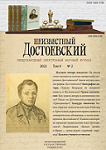Достоевский как прототип незавершенной повести Некрасова «В тот же день часов в одиннадцать утра…»
Dostoevsky as a Character Prototype in Nekrasov’s Unfinished Short Novel “On the Same Day at Eleven o’Clock in the Morning…”
Author(s): Daniil A. IudinSubject(s): Russian Literature, 19th Century, Theory of Literature
Published by: Петрозаводский государственный университет
Keywords: Dostoevsky; Nekrasov; Belinsky; Panaev; brilliant; triumph; gossip; scandal; prototype; character;
Summary/Abstract: The article discusses the debatable issues in the study of the unfinished short novel by N. A. Nekrasov about F. M. Dostoevsky. Nekrasov played an important role in the evolution of Dostoevsky’s literary reputation. The novel “Poor Folk” became a sensation in 1845–1846, and its author was called a genius. In the mid-1850s Nekrasov undertook a revision of these events. The prototypes of his characters are real people. The short novel presents three characters: Mertsalov (Belinsky), Glazhievsky (Dostoevsky), Chudov (Nekrasov). Their images are distinctive and unambiguous. Mertsalov is contradictory: he greets the young writer with enthusiasm, but he is cruel and demanding of “literary sympathizers”, whom he perceives as servants. Only Chudov is revealed as a positive hero. He is not an intriguer, is honest and critical of all participants in this literary story, condemns intrigues and gossip. A character of this work, he is also the author’s alter ego. As a prototype, Dostoevsky is explored in Nekrasov’s text from three perspectives. Acting as a memoirist, Nekrasov presents Dostoevsky as a writer and as a historical figure. A documentary approach prevails in these episodes, the author uses the facts of the biography of the writer, who found himself at the epicenter of St. Petersburg literary life in the mid-1840s. As a critic, Nekrasov analyzes the creative experience of early Dostoevsky, recognizing Makar Devushkin and Golyadkin in the author. As a journalist and editor, Nekrasov presents Dostoevsky as a character of gossip, rumors, Belinsky’s satirical message to Dostoevsky, I. Panaev’s feuilletons. This is an exaggerated and caricature image of a young genius who is not ready for this role, who is insolvent as a person, and therefore ridiculed and rejected by Belinsky’s entourage. Nekrasov made the story of Glazhievskiy an instructive one. The author exposes his characters. There are contradictions within the characters, but no complexity. He is interested in the subject matter, but not in its participants. At first, Nekrasov was carried away by the topic, but later lost interest in it.
Journal: Неизвестный Достоевский
- Issue Year: 9/2022
- Issue No: 2
- Page Range: 58-85
- Page Count: 28
- Language: Russian

